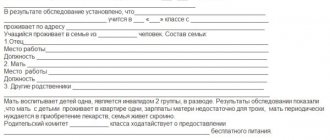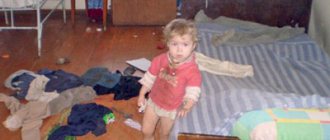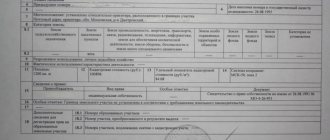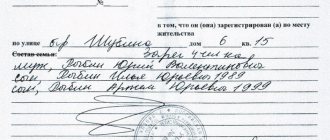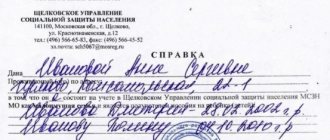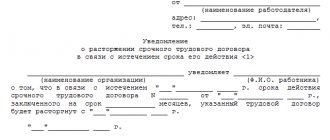In the field of protecting the rights of minor children, it is possible to inspect the place of his residence and draw up a report on the inspection of living conditions. Such a document is also drawn up when adopting a child, receiving a complaint to a government agency, law enforcement agencies, registering guardianship and trusteeship, etc. One of the responsibilities of the class teacher in educational institutions is to check the conditions in which his students grow and are educated. By the way, an inspection report on living conditions can also be drawn up in relation to the organization’s employees, if necessary.
In general, there are no official requirements for the content of acts. However, Order of the Ministry of Education of Russia dated January 10, 2019 N 4 established a special procedure and introduced the form of an act when conducting a survey of the living conditions of minors and their families
Download:
Act of inspection of the living conditions of a minor citizen and his family
An example of a housing inspection report
Living conditions inspection report
April 20, 2021 Zhukovsky, Moscow region
The commission consists of: teacher MBOU "Secondary School No. 125" Zhukovsky Anna Viktorovna Solarova, social teacher MBOU "Secondary School No. 125" Zhukovsky Lazarev Igor Aleksandrovich, member of the parent committee of grade 7 "B" Kolosov Petr Valerievich,
On April 20, 2021, I checked the living conditions of the student of grade 7 “B” of MBOU “Secondary School No. 125” in Zhukovsky, Bogdan Dmitrievich Shcherbinin.
Family composition: complete. Mother - Shcherbinina Anna Romanovna, father - Shcherbinin Dmitry Timurovich, younger sister - Shcherbinina Alisa Dmitrievna.
All family members live together in apartment No. 48 at the address: Moscow region, Zhukovsky, Lenina Ave., 205. The apartment with amenities is located on the 6th floor of a 12-story brick building, total area 56 sq. m. m.
Student Shcherbinin B.D. lives in a living room with an area of 25 sq. m., together with his younger sister (attends a preschool). Part of the room is allocated to separate sleeping areas. There are 2 separate workstations equipped with stationery and school supplies. There is a horizontal bar for sports and a shared play area. The child has the conditions for proper rest, sleep and study.
No violations of sanitary and hygienic standards were found during the inspection. The apartment is clean, warm, things are laid out neatly. All family members look neat.
Mother and father work at a permanent place of work, the family income is average. Children are provided with clothing, proper nutrition, and attend additional sections and clubs. Family relatives (grandparents) live separately. They visit them weekly.
The commission’s conclusion: no obvious signs of trouble were found when visiting the family. There are good friendly relations between family members. The child is provided with everything necessary according to his age.
Commission members
Solarova A.V.
Lazarev I.A.
Kolosov P.V.
Dysfunctional family
The Ministry of Internal Affairs often carries out inspections of dysfunctional families, especially if this is preceded by a protocol on violations. In such a situation, the verification certificate is additionally sent to the police.
In such a document, more attention is paid to the financial condition of the family, health (in particular, the presence or absence of signs of beatings), and so on. We are also actively interviewing neighbors who may have heard or seen something related to the dysfunctional family.
Why is a housing inspection report drawn up?
The purpose of drawing up the document is to record living conditions and prepare a conclusion: whether the basic needs of the child are provided by the persons with whom he lives, or whether they are ready to accept the child (upon restoration of parental rights, etc.). Or whether the citizen needs to improve their living conditions, etc. If damage is caused to the apartment, it would be correct to draw up an Apartment Inspection Report.
An inspection report of housing conditions is necessary when considering claims for deprivation of parental rights, their restoration, determination of the child’s place of residence, adoption of a child, etc. The obligation to draw up such a document is assigned when registering a child in the children's room of the police, in cases where a minor is brought to administrative or criminal liability.
The composition of the commission depends on the purpose of drawing up the housing inspection report. These can be police officers (as a rule, local police officers), employees of guardianship and trusteeship authorities, school teachers, employees of the BTI, housing maintenance organization, etc. An inspection of living conditions can also be carried out based on a complaint from neighbors or a doctor’s request.
Where can I get a certificate?
You can order and obtain a certificate of examination of the living conditions and financial security of the family from the social protection authorities. At the same time, as mentioned above, other structures, including even the Ministry of Internal Affairs (Ministry of Internal Affairs), can initiate the inspection.
Since in different regions different structures (by name) may be responsible for completing the application and verification, it makes sense to contact the local administration first. They will tell you who issues such a document.
This is important to know: The deadline for transferring alimony in 2021
Contents of the housing inspection report
The housing inspection report is drawn up in free form, and its structure is determined by the purpose. The general requirement for such documents (in order to have the force of evidence in a civil case or have legal significance) is:
- Availability of a date for conducting a housing inspection. It may coincide with the date of drawing up the act, or it may differ (the act must be drawn up no later than 3 days after visiting the property)
- Name of the document (act), date and place of its publication
- Members of the commission and the purpose of the inspection (we are checking the student, in connection with a complaint from neighbors, etc.)
- Object of study (address) and characteristics of housing (house, apartment, area, how many rooms, who owns it, in which house it is located, amenities, etc.)
- Who lives in the apartment - family composition, other relatives or other persons living together, sometimes their place of work and income, behavior, appearance
- Availability of pets, cleanliness, arrangement, etc.
The document may contain conclusions and conclusions about the compliance of housing and sanitary conditions with standards. The act of examining housing conditions is signed only by members of the commission, but the persons whose living conditions were checked and their legal representatives have the right to familiarize themselves with the document.
Deadlines
There is no strictly defined period during which the inspection will be carried out. On average, this takes about 1-2 months.
Expert opinion
Kurtov Mikhail Sergeevich
Practitioner lawyer with 15 years of experience. Specializes in civil and family law. Author of dozens of articles on legal topics.
After this, the act must be drawn up within three working days, and it remains valid for another 30 days. If the act for some reason does not suit the residents of the apartment, they have the right to challenge it within 10 days after receipt.
The procedure for conducting an examination by the guardianship authority according to Order of the Ministry of Education of Russia dated January 10, 2019 N 4
The examination is carried out in order to identify circumstances indicating a lack of parental care over a minor citizen, and to take measures to protect the rights and interests of children in cases of death of parents, deprivation of their parental rights, restrictions on their parental rights, recognition of parents as incompetent, illness of parents, long-term absence parents, evasion of parents from raising children or from protecting their rights and interests, including the refusal of parents to take their children from educational organizations, medical organizations, organizations providing social services, or similar organizations, when the actions or inaction of parents create conditions that constitute threat to the life or health of children or interfering with their normal upbringing and development, as well as in other cases of lack of parental care.
The examination is carried out by the guardianship and trusteeship authority or by an educational organization, a medical organization, an organization providing social services, or another organization, including an organization for orphans and children left without parental care, which, in accordance with the Rules for the exercise of certain powers of the guardianship and guardianship authorities guardianship of minor citizens by educational organizations, medical organizations, organizations providing social services, or other organizations, including organizations for orphans and children left without parental care, approved by Decree of the Government of the Russian Federation of May 18, 2009 N 423 , the authority of the guardianship and trusteeship body has been transferred to identify minor citizens in need of establishing guardianship or trusteeship over them, including examining the living conditions of such minor citizens and their families.
The basis for the examination is oral and written requests from legal entities and individuals containing information about children received by the guardianship and trusteeship authority or organization at the actual location of the children.
The examination is carried out by an authorized specialist (specialists) of the guardianship and trusteeship body or organization within three days from the date of receipt of the information.
Student
An inspection of the living conditions of a student, whether a schoolchild or a student, is carried out mainly on the initiative of the director of the educational institution, although this is not a mandatory rule. In particular, the readiness of the place for study, the presence of a table, chair, lighting sources and other features are checked.
This includes checking the availability of everything necessary for studying, from blank sheets to pens/pencils. The completed report is submitted not only to the social security authorities and the homeowner, but also to the educational institution that initiated the inspection.
What is revealed during the examination?
During the examination, the following is revealed:
1. Level of provision of the child’s basic needs:
- Health status: general visual assessment of the level of physical development and its correspondence to the child’s age, the presence of diseases, special needs for medical care, drug provision; presence of signs of physical and (or) mental abuse of the child; an explanation from parents and/or persons living with the child about signs of violence in the child; presence of cases of child abuse in the past.
- Appearance: compliance with the child’s personal hygiene standards, availability, quality and condition of clothing and shoes, their compliance with the season, as well as the age and gender of the child, etc.
- Basic care: meeting the child’s basic needs - food, shelter, hygiene, clothing, medical care; the child’s daily routine, sleep patterns, their correspondence to age and individual characteristics.
- Social adaptation: the presence of communication skills with others, self-care skills in accordance with the age and individual characteristics of the child’s development, the adequacy of the child’s behavior in different environments, etc.
- Upbringing and education: name of the organization(s) carrying out educational activities, including institutions of additional education for children, which the child attends, the form and success of mastering educational programs in accordance with the age and individual characteristics of the child’s development ; organizing the child’s free time and recreation; the presence of a developmental and learning environment.
- Satisfying the child's emotional needs.
2. Family environment of the child:
- Family composition, who actually cares for and supervises the child; the presence and place of residence of close relatives of the child, the degree of participation of parents and other persons living together, relatives in the upbringing and maintenance of the child; the degree of attachment and relationship of the child with parents and family members.
- The relationships between family members, their nature; features of relationships between family members, the impact of these relationships on the child, changes in family composition in the present and past, distribution of responsibilities in the family.
3. Housing, living and property conditions:
- Living conditions in which the child lives: the presence and ownership of living quarters, its total and living area, number of rooms, landscaping and sanitary and hygienic condition; the child has a separate equipped place (room, corner) for sleep, games, activities; availability of personal belongings (toys, books, etc.) in accordance with the child’s age, etc.
- Ensuring the safety of the child in accordance with his age (lack of access to dangerous household items, medicines, electrical appliances, gas, etc., risk of harm to the child both at home and outside the home).
- Family income structure: main sources of income (income of parents and other family members, alimony, pensions, benefits, other social benefits); average monthly and per capita family income; information about the property and property rights of the child; information about ensuring the basic needs of the child.
4. The presence of circumstances that pose a threat to the life and health of the child, his physical and moral development, or violate his rights and interests protected by law; facts of neglect, cruel, rude, degrading treatment, insult or exploitation of a child, physical or mental violence against a child, an attempt on his sexual integrity.
During the survey, such forms of obtaining information are used as a conversation with the child, his parents and other family members, a survey of people who have data on the relationship between the parents and the child, their behavior in everyday life, observation, study of documents, educational and creative works of the child, and others.
During the survey, the confidentiality of citizens' personal data is ensured.
Minor
This check is carried out in relation to a minor citizen, for example, a ward child, a schoolchild or even a student, if the latter has not yet reached the age of majority. As a result of data analysis and inspection, the following features are revealed:
- Family (complete or incomplete).
- The income level of the parents and, if relevant, of the minor child. Usually it is indicated not just in one number, but with a list: how much is for each person, where the money is spent, and so on.
- The child's health status.
- Compliance of the premises with sanitary and hygienic standards.
- General characteristics of the premises.
- Condition, quality and quantity of clothing and shoes.
- The child’s mental state, how he behaves, how adequately he behaves, and so on.
- The presence in the apartment of separate rooms or areas for recreation or activities of the child.
Registration of results
Based on the results of the survey, a report on the living conditions of the minor citizen and his family is drawn up, containing:
- assessment of the circumstances identified during the survey;
- conclusions about the presence of conditions that pose a threat to the life or health of the child or impede his normal upbringing and development;
- conclusions about the presence of circumstances indicating a lack of parental care over the child; recommendations on the form of protection of the rights and legitimate interests of the child.
The survey report is drawn up within 3 days from the date of the survey, signed by the authorized specialist of the guardianship and trusteeship body or organization who conducted the survey, and approved by the head of the guardianship and trusteeship body or organization.
The inspection report carried out by the organization is drawn up in two copies, one of which is sent to the relevant guardianship and trusteeship authority within 1 day following the day of its approval, the second is stored in the organization.
A copy of the examination report, certified by an authorized official of the guardianship and trusteeship body of a constituent entity of the Russian Federation or a local government body (if by law of a constituent entity of the Russian Federation, local government bodies are vested with powers of guardianship and trusteeship in accordance with federal laws) or the head of the organization that conducted the examination, is sent to the parents ( legal representatives) of the child within 3 days from the date of approval of the examination report if there is information about the place of residence or place of stay of the parents (legal representatives) of the child.
If, based on the results of the examination, circumstances are revealed that indicate the absence of parental care of the child, the organization is obliged, within 1 day following the day of the examination, to report this to the guardianship and trusteeship authority at the place of the child’s actual location.
Procedure
- Contact the local administration and check the social security contacts (this point can be skipped if the applicant knows where the social security is located).
- Contact the social security authorities and submit an application for verification.
- Receive a receipt confirming that the application has been accepted and will be considered.
- After this, a special commission is assembled to consider the application.
- Based on the results of the commission meeting, a date and time for the inspection are set, and the applicant is informed about it.
- At the specified time, the applicant is obliged to provide access to the residential premises.
- An inspection is carried out, which includes not only an inspection of the property, but also communication with neighbors, family members of the applicant, responsible representatives of the housing office or management company (management company), local police officer, and so on.
- An inspection report on living conditions is drawn up.
- The document bears the signatures of the applicant, his family members, as well as all members of the commission that conducted the inspection.
- The act is fully drawn up, stamps are affixed and the document is registered. Only after this one of the copies is given to the applicant.
What documents are needed
If the property of a minor is being sold, then the following documents are needed:
- a well-written application for an inspection;
- passports and documents for the child;
- documentation for real estate obtained from Rosreestr and BTI;
- a preliminary contract for the purchase and sale of an object, which is signed with the second party to the transaction.
If legal proceedings , then an extract from the house register , technically documents for housing and evidence of the need for an examination are additionally requested.
Form
Such checks are carried out by special commissions. All details, including conclusions, are recorded using the appropriate act. To compile it there is no need to use a unified form. The document is drawn up in a free style. But, despite this, detailed information must be present not only about the home being inspected, but also about family members.
What types of living conditions are there?
- Unsatisfactory . As a rule, this type involves gross violations of hygiene and sanitary standards. For example, this may be excessive dampness, the appearance of fungus and mold, poor lighting, or water undrinkable. This is also the poor technical condition of the home, for example, parasites in the apartment, fallen plaster, leaking roof, wobbly walls.
- Satisfactory . Electricity, water supply, gas supply and other communications are present. But at the same time, the family may still need some help. For example, if a family has 3-5 people, but lives in a one-room apartment. Accordingly, these residents need to expand their living space.
- Comfortable . Essentially, this category includes conditions that are above average. In addition to the basic ones, the family also has additional conditions. For example, a large home is located near shops, schools, and medical institutions. The house has security and a concierge. The home is located in an area with developed infrastructure.
As you might guess, depending on the type of conditions, a decision is made to register as a family in need of social assistance. Some may have thoughts about deliberately worsening their living conditions in order to receive help from the state. However, this is pointless. You need to know that if such fraud is discovered, the family will face serious punishment.
When is a living conditions inspection carried out?
If we talk about children, then checking their living conditions can be carried out in different cases:
- regular violation of discipline in educational institutions. These include fighting, truancy, inappropriate communication with teachers and peers;
- the child is registered with the police;
- guardians have decided on parental rights, and it is decided where he will continue to live;
- adoption of a minor. In this case, the living conditions of the new family are carefully checked;
- change of place of residence. Inspecting authorities must make sure that the child’s living conditions in the new home will not deteriorate;
- teachers or neighbors contacted social services. Usually these are complaints about harsh parental behavior towards the child;
- the child needed medical attention due to a domestic injury. Perhaps it was not obtained by accident, and not due to the cruel treatment of guardians;
- the minor is under investigation or a police report has been filed against him.
You need to understand that checking your living conditions can prevent undesirable consequences. The commission does not always come by prior agreement. Often the inspection team can “swoop in” without warning, which will allow you to see the real picture.
Why is a housing inspection report drawn up?
Thanks to home inspections, responsible authorities identify disadvantaged families who need help. The inspection commission must determine the causes of such problems. For example, if such a situation arose due to life circumstances, the family may be entitled to social assistance. However, often a family is considered dysfunctional precisely because of the parents. In this case, the responsible authorities must exert the necessary influence on them. At the same time, parents must understand that if the lives of their children are not improved, they may be taken, for example, to an orphanage.
If a family is preparing to adopt a child, checking living conditions is an important step in this procedure. Here, representatives of the commission must confirm that the adoptive parents have created all the conditions that will allow the child to live a full life.
Minor
When drawing up such an act, the commission determines the standard of living of a child who has not yet reached eighteen years of age. During the inspection, specialists check
- family status and income;
- child health;
- to what extent the housing complies with sanitary standards;
- does the child have clothes and shoes;
- how the child reacts to strangers;
- how safe is living in this house;
- Does the child have a place to sleep, spend leisure time, and do homework?
Sample
Download
Student
The need to check the student’s living conditions arises when he regularly does not complete homework, exhibits bad behavior at school, and communicates aggressively not only with peers, but also with teachers.
Responsible persons check not only the availability of places for recreation and study, but also all necessary school supplies. As you might guess, all conditions must be created for the student so that he has the opportunity to study normally.
Inspectors also determine whether parents help with homework, or whether the child is left to his own devices.
Sample
Download
Dysfunctional family
There are many different reasons why a family may be considered dysfunctional. Some of them, having received this status, try to maintain normal living conditions. However, this does not happen in all families. Many people need help from social services.
If housing conditions do not meet the requirements, the commission must determine the reasons why this situation arose. Often this is due to the fact that family members simply do not want to lead a normal lifestyle. Often, the inspection team includes a psychologist, who must explain to family members that they have chosen the wrong lifestyle.
There are situations when, after such preventive work, it is revealed that the family continues to behave immorally, use alcohol and drugs, do not raise children, or, conversely, raise them too harshly. In this case, the family may be denied social assistance.
If there are children in the family, social workers may raise the issue of depriving parental rights.
- Sample
- Download
- Young family
As for checking the living conditions of a young family, there are many contradictions. Experts say there is no point in such checks, since many young families are not able to create good conditions for themselves.
But here it is necessary to understand that the state does not want to punish in any way. On the contrary, its goal is to identify families who need help.
For example, if a family lives in poor housing conditions, it may be put on a waiting list for a new apartment.
But to receive such help, living conditions must really be bad. If there is no renovation in the apartment, it can simply be done. Things are much worse if the apartment is too small.
The law stipulates that each family member must have at least 18 square meters. Today there are many families where each member has no more than 10 square meters of living space.
Naturally, such situations are unacceptable.
In addition, responsible persons must determine the social status of young people. Do they have a job or are they still undergoing training? If they do not work, the reason for the lack of work should be determined. Perhaps they need help finding a job. With an immoral lifestyle, a young family may need consultation with psychologists, narcologists and other specialists.
Sample
Download
Housing tenancy agreement: sample and how to draw it up correctly without harm to yourself
- inconsistency of the student’s behavior with generally accepted norms;
- consumption of alcohol, drugs and other substances by minors;
- registering the child with law enforcement agencies;
- third parties filing a complaint about the parents’ improper fulfillment of their obligations;
- a move that could affect the deterioration of the family’s living conditions;
- the appearance of a child with injuries, in a depressed physical or emotional state.
With the help of an audit, all the circumstances that led to the emergence of one or more of the above cases are identified.
In addition, it is determined:
- the condition of the apartment and other place of residence of the minor;
- number of living citizens;
- actual financial condition;
- the health status of all people living with the child, as well as compliance with sanitary and hygienic standards;
- the condition of the places allocated for games, study and recreation for the student.
